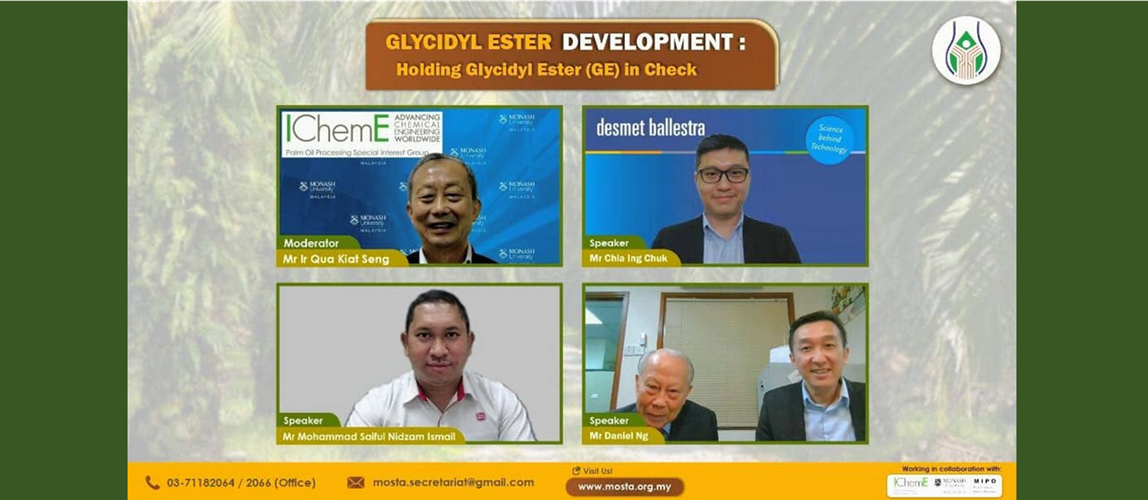Palm Oil Processing
Holding Glycidyl Esters (GE) in Check Webinar

16th April 2021
Introduction
Tan Sri Datuk Dr Augustine Ong, the President of MOSTA, is very keen to see 3-MCPDE (3-monochloropropanediol esters) and GE (glycidyl esters) managed and stresses that as “we know the chemistry of the formation and elimination of Glycidyl Esters (GE) and 3-MCPDE” better and more economical ways of removing them will be found. POPSIG and MIPO agree and this time 5 chemical engineers came together to share with participants the latest developments.
In 2020 MOSTA organized two events viz. a Workshop on Mitigation of 3-MCPDE on 19th April and a Webinar on Mitigation of 3-MCPDE and GE: Industry Practice on 15th October. As there was less discussion on GE, given that its maximum level was set as far back as 2018 by the European Commission, Tan Sri suggested to focus on GE. Ir. Qua Kiat Seng, who wrote an article in The Chemical Engineer (February 2021 issue 956) “Oils & Fats: Essential Engineering”, agreed to be the moderator.
Mr. Chia Ing Chuk, En. Mohammad Saiful Nidzam Ismail and Mr. Alexey Shevchenko came on board as speakers. As the webinar would be very early in the morning in Copenhagen, Shevchenko sent in a recording and Mr. Daniel Ng, Vice President, Food & Water Division of Alfa Laval in South East Asia was on hand to answer questions. So we have the 5 chemical engineers.
Desmet Ballestra
Mr. Chia’s paper was “Mitigating process contaminants during palm oil refining: how to prevent the formation of GE and how to eliminate GE once formed.”
A low DAG (diacylglyceride) content of less than 3-4% in crude palm oil is a prerequisite to keep the GE in deodorized palm oil below 2ppm. GE formation depends on time and temperature and there is almost no net formation of GE below 230°C. A dual high temperature fast stripping and low temperature deodorization column can serve the purpose.
Glycidyl esters can also be ‘removed’ from refined oil by post-bleaching with acid activated bleaching earth followed by mild deodorization. Here GE is converted to monoglycerides. While this double refining step comes with higher operating cost the GE will be considerably less than 0.5 ppm in RBD palm oil fractions.
Desmet Ballestra offers 3 mitigation routes
- Qualistock+TM Dual Temperature Deodorisation: 0.36 ppm GE
- Post stripping of GE from Refined Palm Oil: 0.14 ppm GE
- Mild Post Refining with 2nd bleaching and 2nd deodorization: 0.15 – 0.40 ppm GE
Desmet Ballestra recommends their SublimaxTM 2G vertical ice condenser to achieve vacuum as low as 1.5 mbar.
Sime Darby Plantation (SDP)
En. Saiful’s paper was “Sime Darby Plantation’s Journey in Mitigating Glycidyl Esters (GE) Formation in Refine Palm Oil.”
As an integrated organization SDP undertakes upstream initiatives in the mitigation of GE whilst Sime Darby Oils (SDO) focuses on mitigation at the refinery. Their R&D has evaluated 4 technologies in mitigating GE viz. chemical refining, refining at low temperatures, double refining and post-stripping at refinery.
SDO has reviewed several options (see Fig. 1) for mitigation and can choose CPO Washing + Post-stripping or Chemical Refining depending on the specifications to meet. Chemical Refining has higher OPEX than CPO Washing + Post-stripping.
View Figure 1 in the PDF article.
Alfa Laval
Mr. Alexey Shevchenko’s paper was “Alfa Laval PalmFlex refining technology: reduction of GE and MOSH in refined palm oil”
The latest challenges of hazardous compounds in edible oils & fats are 3-MCPDE, GE and mineral oil hydrocarbons (MOSH & MOAH).
Alfa Laval offers the chemical refining route to produce NBD (Neutralised Bleached and Deodorised) oil for infant formula. The PalmFlex route offers a most optimum refining route with the following stages
- CPO washing, degumming & bleaching
- Deacidification/Deodorisation
- PalmFlex GE Stripping
to produce RBD oil low in GE (0.3 - 0.5 ppm), 3-MCPDE (< 1 ppm) meeting FFA, colour and blandness specifications.
MOSH (Mineral Oil Saturated Hydrocarbons) are mostly C20 & above ranging from 10 to 120 ppm in crude palm oil. It is coming mainly from operation malpractices. MOAH (Mineral Oil Aromatic Hydrocarbons) is lower than MOSH by a factor of 10. There is no EU legislation regulating the limits of MOH in vegetable oils and fats though large food companies are setting their own standards.
MOH pose potential health hazards in animal studies. For MOSH & MOAH C10-C24, high temperature deodorization with steam stripping and vacuum could reduce them. For C24-C30 only partial removal is possible. Good manufacturing practices is the best way to address this issue although food-grade lubricants could also be used.
Q&A
For this session Mr. Chia and En. Saiful were joined by Mr. Daniel Ng.
Ir. Qua took questions first from participants who had sent in their questions based on the slides that were shared with them earlier. There were a dozen questions with 4 questions specifically for En. Saiful.
Questions came in during the webinar which was live on FaceBook. There were about 15 questions. It was a very active Q&A session with all 3 panelists addressing most questions.
At the end of the webinar Ir. Qua reminded participants of the forthcoming Oils And Fats International Congress 2021 (OFIC 2021) from 15th June - 16th June 2021 at Hotel Istana, Kuala Lumpur. You can get more details at http://mosta.org.my/ofic-2020/
At the end of the successful webinar the moderator and speakers posed for a group photo with Tan Sri Datuk Dr Augustine Ong.
Back to group news